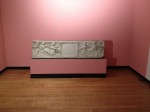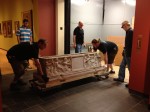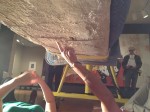
Amherst College’s Mead Art Museum has acquired a rare Roman sarcophagus decorated with sea creatures and engraved with a desperately sad inscription. It was made in Italy out of expensive white Carrara marble around 165-180 A.D. It is 5’8″ long and has carved sea centaurs holding the inscription on both sides while sea nymphs ride on their fishy hindquarters and cupids hover in the corners. This beautiful coffin was the final resting place of two young children who left behind a despairing mother. The Latin inscription tells the tragic tale.
To the departed spirits of Laberia Alexandria, who lived 10 years, 5 months, 7 days, and of Sylvanus, who lived 6 years, 5 months, 14 days.
In this sarcophagus, the unhappy mother buried two bodies, her children, forever to live in sorrow. She survives her children and leads a most miserable life — her husband snatched away by death, the father of these poor little ones.
The second paragraph is a four-line poem in dactylic hexameter in the original Latin. To welcome the sarcophagus to the  Mead collection, Amherst alumnus, professor, former U.S. poet laureate and two-time Pulitzer Prize winner Richard Wilbur composed a new verse translation of the poem in iambic pentameter:
Mead collection, Amherst alumnus, professor, former U.S. poet laureate and two-time Pulitzer Prize winner Richard Wilbur composed a new verse translation of the poem in iambic pentameter:
In this sarcophagus, two children lie
Whose mother’s eyes shall nevermore be dry.
Her husband’s gone, who sired these luckless dears.
His childless widow faces empty years.
Richard Wilbur recited the poem when the sarcophagus made its official debut last month at opening of This Just In! Additions to the Collection from Pompeii to Today, an exhibition that runs through December 29th, 2013. After the exhibition is over, the sarcophagus will remain on permanent display.
The Mead is very fortunate to have had the opportunity to acquire such a compelling and rare piece. One of the things that makes it so rare is that it’s in compliance with the UNESCO Convention on the Means of Prohibiting and Preventing the Illicit Import, Export and Transfer of Ownership of Cultural Property because it left Italy in the early 20th century. Until last year, it was in the permanent collection of the Princeton University Art Museum which is where the Mead acquired it.
In an era when most antiquities with a legally and ethically “clean” provenance are securely held onto by museums, the Mead was fortunate to have Sarcophagus with Sea Creatures become available for purchase. “I never imagined, in my entire career, having the opportunity to participate in a museum acquisition of such an important antiquity,” says Mead director, Dr. Elizabeth E. Barker. Given the infrequency with which works that meet the strict criteria of the UNESCO convention concerning antiquities become available to museums, Barker remains “gratefully amazed to have secured such a rare specimen for Amherst.” Its availability, says the chair of the Mead advisory board, Charles (Sandy) Wilkes, was recognized as “perhaps a once-in-a-generation opportunity to purchase a significant work that helps strengthen the Mead’s collection in a clearly important area.”
 It appears to have been a private sale between the two institutions, or at least, I could find no evidence of a public sale or auction, nor is anybody talking about how much money changed hands. There’s little information about the provenance of the sarcophagus either, not where it was discovered or when it exactly it was sold and exported from Italy. All we know is that it was used as a fountain or watering trough for some time before doing tours of duty as a decorative element in the courtyards of two Roman palazzos. (The sarcophagus as water fountain thing is surprisingly common. We had one in the play yard of my elementary school in Rome. Nobody thought anything of it at the time, although in hindsight it seems kind of amazing to me that we drank from a tap whose basin was an ancient coffin.)
It appears to have been a private sale between the two institutions, or at least, I could find no evidence of a public sale or auction, nor is anybody talking about how much money changed hands. There’s little information about the provenance of the sarcophagus either, not where it was discovered or when it exactly it was sold and exported from Italy. All we know is that it was used as a fountain or watering trough for some time before doing tours of duty as a decorative element in the courtyards of two Roman palazzos. (The sarcophagus as water fountain thing is surprisingly common. We had one in the play yard of my elementary school in Rome. Nobody thought anything of it at the time, although in hindsight it seems kind of amazing to me that we drank from a tap whose basin was an ancient coffin.)
 In August of this year, professional art handlers from Marshall Fine Art Services moved the 1,400-pound sarcophagus into the museum and hoisted it onto its new pedestal, a custom aluminium piece funded by a grant from the Butler Family Foundation in memory of longtime museum supporter Kate Butler Peterson. While the handlers lifted the sarcophagus into the place, Mead antiquities expert Dr. Pamela Russell took advantage of the rare opportunity to examine the bottom of the coffin. The bottom is almost always covered by 1,400 pounds of marble, so having a chance to explore it might well reveal previously unknown details about the history of the sarcophagus.
In August of this year, professional art handlers from Marshall Fine Art Services moved the 1,400-pound sarcophagus into the museum and hoisted it onto its new pedestal, a custom aluminium piece funded by a grant from the Butler Family Foundation in memory of longtime museum supporter Kate Butler Peterson. While the handlers lifted the sarcophagus into the place, Mead antiquities expert Dr. Pamela Russell took advantage of the rare opportunity to examine the bottom of the coffin. The bottom is almost always covered by 1,400 pounds of marble, so having a chance to explore it might well reveal previously unknown details about the history of the sarcophagus.
I wonder if their poor wealthy mother bought that coffin second hand or if the coffin was custom made. To be precise, I wonder if its maker built it to order, or if they had undertakers in ancient Rome who had prefabricated coffins on display. Of course, marble from Carrara was shipped all over the Mediterranean. At the age of 10, however, my parents took me to Massa for summer vacation where I used to paddle in a rubber dinghy, and I still remember that from out there, the rocks of Carrara where clearly visible in the hinterland. Could the two children possibly have drowned, and hence have been depicted as eternally riding on these sea creatures ? …OK, that guess might be nonsense.
– P.S.: Writing this, I remember that the only sea creatures that I could see from that dinghy of mine were virtually tons of rather ignorant jellyfish.
A quick web search turned up nothing regarding Princeton’s decision to sell the work. I wonder what that was all about?
This is an unusually beautiful sarcophagus, with a regrettably tragic history.
I also have a question: I am currently writing an article on nature spirits for an American non-profit academic journal, and wonder if it would be possible for me to use the scene from one half of this sarcophagus as an illustration of Roman sea creatures.
If so, would you be able to send a high resolution image to me me or the publisher? And if this would be okay, how much would it cost?
Thank you very much –
Lynda Harris
(art historian, based in London)